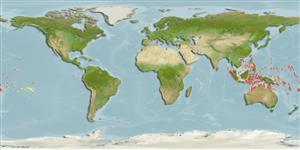Common names from other countries
>
Gobiiformes (Gobies) >
Gobiidae (Gobies) > Gobiinae
Etymology: Eviota: No etymology given, suggested by Christopher Scharpt: from Latin 'eu' for 'true' and 'iota' for anything very small, in combination 'truly very small' referring to it as being the smallest vertebrate at the time it has benn described by Jenkins (thus, making the suggestion by Scharpt plausible..
More on authors: Jordan & Seale.
Environment: milieu / climate zone / depth range / distribution range
Ecología
marino asociado a arrecife; rango de profundidad 2 - 17 m (Ref. 90102). Tropical; 21°N - 20°S
Indo-Pacific: from Japan, Taiwan; south through Philippines, Indonesia, Micronesia, to Australia;; east to New Caledonia, Fiji, Tonga, and Samoan Islands to French Polynesia (Society Islands) and Pitcairn Island.
Tamaño / Peso / Age
Maturity: Lm ? range ? - ? cm
Max length : 1.7 cm TL macho / no sexado; (Ref. 28620)
Espinas dorsales (total): 6 - 7; Radios blandos dorsales (total): 8-10; Espinas anales 1; Radios blandos anales: 7 - 8. This species is distinguished by the following characters: cephalic sensory-canal pore system without the IT pore only (pattern 2); branched pectoral-fin rays; fimbriate urogenital papilla; dorsal/anal-fin formula 9/8; fifth pelvic-fin ray rudimentary or absent; pectoral-fin base no dark spots; subcutaneous bars on body 5 between anal-fin origin and caudal fin; a large rectangular dark spot on mid and upper caudal peduncle (Ref. 107299).
Inhabits algal covered rocks, rubble, or corals (Ref. 1602).
Life cycle and mating behavior
Madurez | Reproducción | Puesta | Huevos | Fecundidad | Larva
Myers, R.F., 1991. Micronesian reef fishes. Second Ed. Coral Graphics, Barrigada, Guam. 298 p. (Ref. 1602)
IUCN Red List Status (Ref. 130435)
CITES (Ref. 128078)
Not Evaluated
Threat to humans
Harmless
Human uses
Más información
ReferenciasAcuiculturaPerfil de acuiculturaRazasGenéticaElectrophoresesheritabilidadEnfermedadesProcesamientoMass conversion
ColaboradoresImágenesStamps, Coins Misc.SonidosCiguateraVelocidadTipo de nataciónSuperficie branquialOtolitosCerebrosVisión
Herramientas
Special reports
Download XML
Fuentes de Internet
Estimates based on models
Preferred temperature (Ref.
115969): 26.7 - 29.3, mean 28.6 (based on 1838 cells).
Phylogenetic diversity index (Ref.
82804): PD
50 = 0.5000 [Uniqueness, from 0.5 = low to 2.0 = high].
Bayesian length-weight: a=0.01023 (0.00477 - 0.02194), b=3.02 (2.84 - 3.20), in cm Total Length, based on LWR estimates for this (Sub)family-body shape (Ref.
93245).
Nivel trófico (Ref.
69278): 3.0 ±0.3 se; based on size and trophs of closest relatives
Resiliencia (Ref.
120179): Alto, población duplicada en un tiempo mínimo inferior a 15 meses (Preliminary K or Fecundity.).
Fishing Vulnerability (Ref.
59153): Low vulnerability (10 of 100).
